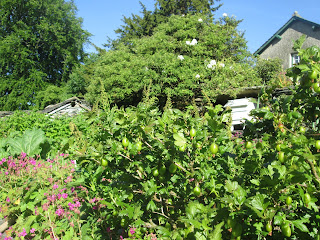Thinking about how to begin this
month's post I realised that Beatrix and I have a few different
things in common – a rather snappy dress sense, a thing for the
sheeps (I am Welsh after all.. or at least that's my excuse) and we
both have a bit of a thing for adventuring
around and exploring new places.
Beatrix may never have ventured out of
the United Kingdom but she sure got around, exploring a lot of
different places within the country, something I love doing.
There are all kinds of journeys –
long ones which require a multitude of snacks, small,
little ones that zip past and those you remember for a variety of
reasons.
If you have peeked at the Hill Top and
Beatrix Potter Gallery's
Facebook page over the last few weeks you
will have seen that Michael Portillo brought his railway journey up
to the lakes to see B and the team at Hill Top.
He was here to find out more about
Beatrix, her friendship with Hardwicke Rawnsley and the part she
played in the formation of the National Trust. I was lucky enough to
be able to see some of the filming at Hill Top. I didn't quite get my
on screen debut just yet but watching it happen was interesting so
keep your peepers peeled for it on the tele in the near future!
Micheal P may favour the railways for
his journeys but this isn't the only way to travel check out this
amazing ship that we have at Hill Top.
 |
| Land Ahoooyyy! |
To say that I don't know much about
ships is a huge understatement and my
experience with them is pretty limited – unless rowing a small
wooden boat on Durham River counts? With these long arms I'm
practically made for rowing..
So to find out more about this vessel
I've done what all good detectives would do... I googled!
This is a three
masted ship and apparently made by a sailor between 1870 and 1900-ish. From my research (aka scrutinizing lots of images of ships) I'm
going to make an educated guess and say that this is a type of
schooner? These are sailing vessels with two or more masts often designed for
trades that required speed and windward ability.. trades like,
pirating, “Ohh Arrrg!”
With all those sails I imagine that it
would have had no problem zipping through the waves or lakes!
A slower, more sedate, unconventional
and downright feathery mode of transport is this month's
“Heeeellooooe There!”.
Sure maybe you wouldn't want to use him
for long journeys, mainly because he is
extremely dinky in real life and to be honest he's a bit out of
practice after having been in a cabinet for such a long time.
I know what you're thinking, “A swan
is not a mode of transport!” but I would counter this with, “Have
any of you seen Doctor Doolite?” the original of course... He had
this amazing great big pink sea snail and no one questioned this as a
mode of transport when it was time for Emma to head back to London! I
absolutely love this film, but back to the swan :)
With a
fleur-de-lys painted on one side of his body and a lady in
traditional dress knitting on the other it could have possibly been
produced by Quimper Faience in Brittany, France. This
pottery's design reflects a strong traditional Breton
influence and a lot of the older pieces are strongly sought after.
Luckily for us this little guy is
staying firmly at Hill Top!
 |
| This year's top model pose.. |
He may be petite but he wears some
pretty flamboyant eye makeup.. I mean red eyeliner? That's a bold
statement but he is definitely working
this look. I myself might give it a miss, with
my extremely pale skin I worry I'd end up looking scary rather
than spectacular!
Whether you choose a ship or a swan to
complete your journey you'll need to have a general idea of which way
to go, don't you?
This is down as an ornament on our
inventory, it lives in the ivory cabinet but to be honest I'm not
completely sure of it's actual purpose or even
if it has one..some things are 'just because'.
What are your
thoughts on it?
The hand in the middle twizzles around and to
me could point you in the right direction –
in my mind the numbers could even be routes? (Does this make any
sense or is it just something in my mind??)
My other thought about it was that it
reminded me of the big hand from the old lottery adverts..
 |
| “It could be you!!!” |
Anyway I digress, this object came from
London and is marked on the bottom ‘H Rodrigues, 42 Piccadilly,
London’ – but apart from that we can only guess about its
history. Could this have some to Beatrix from her parents or
grandparents along with the other bits and bobs of ivory?
My own history with Hill Top and
Beatrix has only been relatively small; about 2 and a bit years (ish)
but like Beatrix I’m going on another little journey of my own.
I’m happy to say that I’ll be
working over at Townend from mid-July until the end of October on a
little secondment
However, never fear, this isn’t
farewell, we all take different paths on our journeys and you’ll
still find me strutting my stuff up and down B’s path one day a
week.
There is actually a little connection
with Beatrix and the Browne’s of Townend but more of that next
week!
See you all in July!
Ta ta for now
Words and photos by Natalie



























